Cold summer 41 year
One small digression should be made here. Suvorov-Rezun, describing the insidious plans of the bloodthirsty Stalin to attack defenseless Germany, writes that no state is able to maintain a mobilized multi-million dollar army. Quite a fair comment. Personally, I do not understand why all this applies only to the Soviet Union, because the same can be said about Germany with one small amendment - she mobilized her army much earlier and was by no means going to reduce. But there was an opportunity for this. If Hitler considered the possibility of a war against England alone, he could completely painlessly demobilize half of his divisions. Those left behind would be enough for a war against the British in every imaginable and inconceivable theater. However, this does not happen. On the contrary, the formation of the next 10 tank divisions. Those interested can look at a map of Europe in August 1940 and estimate who they might be needed for a war with. Probably for the occupation of Andorra ...
So let's not be mistaken. If the notorious “Unternehmen Barbarossa” was signed only in December 1940, preparation for it began much earlier, almost immediately, as soon as the fighting in France ended. And the reference of the Germans to the failure of the negotiations in November 1940 of the year is nothing more than an empty excuse. An interesting temporary coincidence: it was in November 1940 of the year that the first three numbered tank groups were created. During the fighting in France, the Guderian and Kleist tank groups were viewed as temporary formations, something like corps combat groups. Now the Pancerwaffe units were transferred to the new status and stood on a par with the Wehrmacht field armies.
But Benito Mussolini intervened in a very inappropriate way. He incited Italy into a war that no one needed, and least of all Italy needed it. Very quickly, Hitler was convinced that when there are such allies, no enemies are needed anymore. He had to save the hapless warrior, and on all fronts that Mussolini opened. First, in February, 1940 had to start sending German troops to Africa, and almost immediately a minor “defensive squad” had to be increased to a whole corps. We wrote about the fascinating tag game between Rommel and the English generals in the previous book, and we'll talk more about what happened near El Alamein and beyond. But in any case, only a couple of divisions were sent to Africa, so this did not particularly affect the preparation of the Barbarossa.
A little later, the situation in the Balkans, where the ghost of a complete catastrophe loomed before the Italians, also became sharply complicated. As a result, in the spring of 1941, Hitler, against his will, was forced to start a small war in the Balkans. And here the German command made a decision, the meaning of which remains rather mysterious. If the reinforcement by the tank corps of the 12 Army, which was advancing on Greece, and the 2 Army, which was on the northern border of Yugoslavia, is quite natural, then the concentration of the entire 1 armor group of General Kleist to strike Belgrade from the south looks mysterious. Balkan theater is not the most suitable for tanks. Numerous mountain ranges, narrow and poor roads, sometimes turning into goat paths, rapid mountain rivers — all this completely deprived the tank formations of their main trump card — mobility. About any detours and blows from the rear could not even dream of. So maybe the German generals just really wanted to brag about a new toy? But for the pleasure you have to pay. And it's not even the case that during the operation “Marita” about 60 tanks were lost, this is quite a bit. Fatigue of personnel and wear of equipment had much more serious significance. For example, the commander of the 9 Panzer Division reported that after going over the mountainous steeps, all the tanks of his division required replacing worn brakes.
But one way or another, by the summer of 1941, the German army was prepared to attack the Soviet Union. Again, the political background of this event does not concern us. We have in the bottom line a couple of facts. Whoever thought or intended to do, but it was Germany that attacked. And even though Ambassador Schulenburg and Foreign Minister Ribbentrop handed the corresponding notes, but the hostilities began even before that. And everything else - from the evil one.
The Germans attracted 17 tank divisions, divided between 4 tank groups, to participate in Operation Barbarossa. The quality of Pancerwaffe changed, but still too slowly, the Germans still had about 40 percent of good-for-nothing TI and T-II of rather dubious combat value. So, if we consider the influence of the characteristics of the German tanks on their tactics, we will find that the German commanders made the most serious efforts to avoid fighting with the new Russian tanks. The T-34 was as well protected as the French tanks, which had already caused a lot of trouble for Guderian and Gotha, and the KB was noticeably better. But at the same time their 76-mm guns, despite all the shortcomings, did not leave the German light tanks any chance of survival.
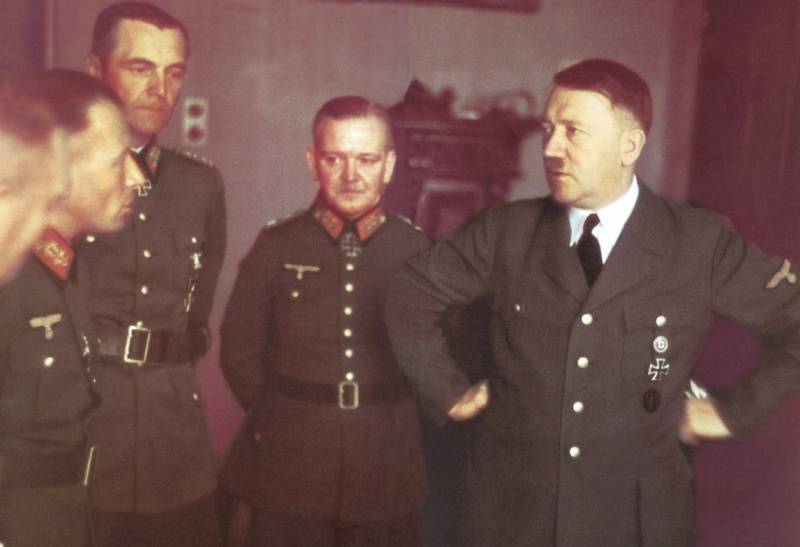
The meeting with the Soviet tanks was an unpleasant surprise for the Germans, but not for the Germans who wrote about it. After all, we are familiar with the terrible impression that T-34 and KB made on the Wehrmacht, mainly from the generals memoirs. Is it worth it to believe so unconditionally? In the end, Descartes also turned into a clear formula the statement of the ancient Greek school of skeptics: “De omnibus dubitandum”. All question. Let us allow ourselves to doubt something.
First of all, we are not dealing with the originals of German memoirs, but with Russian translations, moreover with translations made by the memorable publishing house Voenizdat. Relatively recently, I was led to prepare for the reissue a couple of books that were once published by this office, and it turned out that it was easier to make a new translation than to edit the old one. The fact that they have lost in the amount of about 30 percent is still far from the worst. As it seemed to me, all these publications were viewed from a very specific point of view: from the assumption of the inevitability of the Third World War and battles with former opponents. Therefore, the memoirs of the German generals were considered as textbooks of strategy and tactics, a guide to the features of the structure and actions of a potential adversary. And everything that did not fit into the given framework was mercilessly cut out for complete uselessness. Thus, entire chapters and sections disappeared, but it is not necessary to see here malicious intent. Then editorial scissors entered the business, urging the book on to a given volume and clipping paragraphs, sentences, lines. By the way, sheared out completely unsystematic and inexplicable.
However, there are more serious concerns. Sometimes it starts to seem to me that the translation was done, as it is now said, “politically sound”. Maybe in the output of these memoirs you need to put a mark "Edition revised and enlarged"?
The best example is the book Mellentina "Tank battles 1939 – 1945 years.", Which Smolensk "Rusich" for something renamed "Armored fist of the Wehrmacht", although the military name completely corresponds to the original. An interesting nuance: why does Mellenthin (or not Mellenthin?) Sing all his praises to T-34 from someone else's voice? I do not state categorically that these are inserted quotes, because I have not seen either the German original, or at least an English translation. I just doubt it. The Russian translation of the German book with English inserts raises certain doubts. The most interesting thing is that at the same time Mellenthin (li?) Refers to the book Liddell-Garth "On the other side of the hill", which is a collection of surveys of captured German generals. One more step further? .. But did Mellenthin himself see the T-34 at Stalingrad and Kursk, why does he need such deep bibliographic research?
Or take the so-called memories of General Reinhardt, who commanded the XLI Corps in 1941. The fact is that in fact there is a book “Die Wende vor Moskau. Das Scheitern der Strategie Hitlers im Winter 1941 / 42 ”, published in Stuttgart in the 1972 year. Its author is also General Reinhardt, but a completely different one - Major General of the Bundeswehr, Dr. Klaus Reinhardt. He may be the son of General Oberst Hans-Georg Reinhardt, but he clearly did not write about the battle of Moscow, because he was born in the very year of 1941.
However, even if the memories are written by actual participants in the events, they still raise doubts. Let's start with terrible amazement, allegedly engulfing the German generals when meeting with new Russian tanks. But if we open the memoirs of General Routh, we will see a reference to the order of the commander of the 6 Panzer Division, General Landgraf, given back in early June of 1941. This order contained a direct prohibition against engaging with Russian tanks. The fact is that the 6-division was armed with the notorious “35-ton” tanks, for which the meeting with the T-34 was a very painful way of suicide. So is it that, on one Landgraf, the insight condescended, or did the other Panzer generals also guess about something?
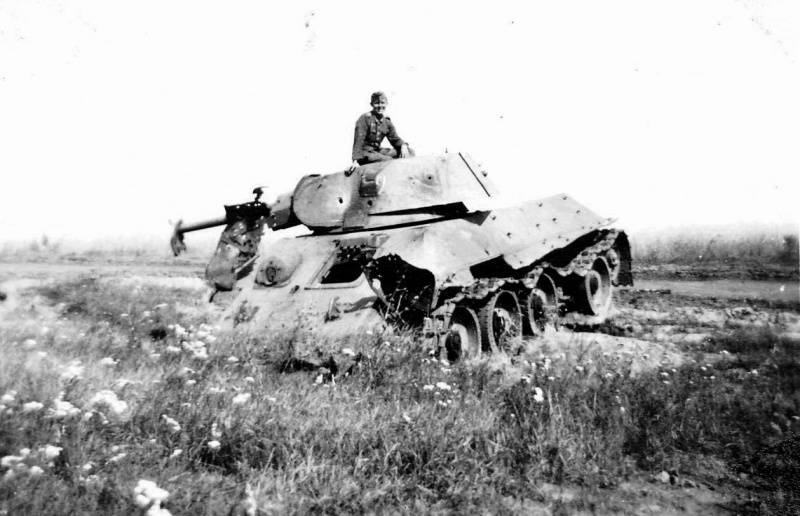
Next, take a closer look at General Halder's diary entries. They also often mention new Russian tanks, but ... Only 50-ton. Halder doesn’t notice the famous “thirty-four”. He expresses doubt: can the tank be armed with an 150-mm gun?
Implied, of course, the tank KV-2. What is it, the chief of the German General Staff does not know what his own army is armed with? The fact is that already during the fights in France the Wehrmacht used self-propelled guns “15 cm sIG 33 auf Pz.Kpfw. I Ausf. AT". It's not me, it's the Germans called them so long. Not so hot the car turned out, but nevertheless it was an 150-mm howitzer on the chassis of a TI tank with a total weight of about 8,5 tons. In the production and development were Sturmpanzer II and self-propelled gun "Bison", armed with the same howitzer. And for some reason they have no surprise for Halder.
In general, some historians have noticed a curious feature. All the troubles of the German generals are to blame: the weather (frost or heat, rain or snow, substitute at will), the stupid Hitler and the T-34 tank. These factors justify any failures and failures, but they do not appear every day. The most vivid example is the well-known quotation from Guderian’s memoirs:
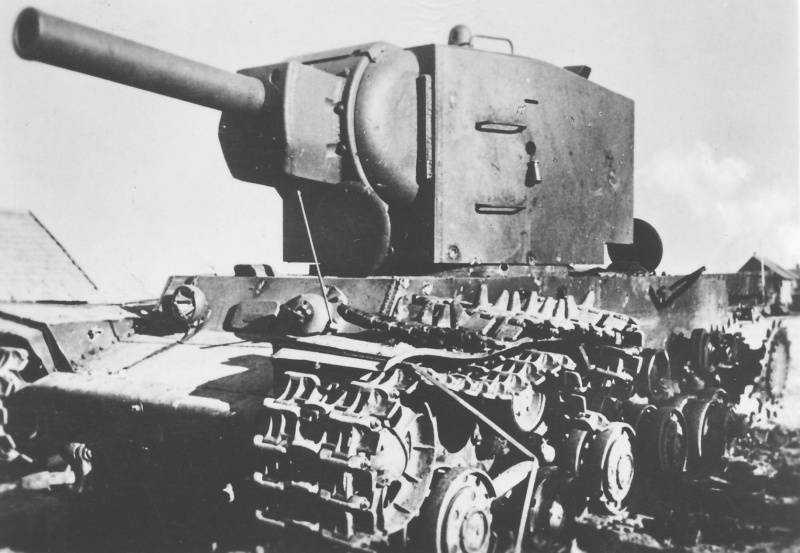
Just let us not believe him. Pay attention to the date - October 11. This fierce fighting near Mtsensk, which ended not too well for the “Swift Heinz”. He came almost to Moscow itself, without noticing the T-34, and suddenly suddenly saw the light. Or maybe just so far he did not need to justify his failures, since there were no failures themselves? But the failures began, and the explanations came in handy.
Well, okay, enough about that. The 1941 Summer Campaign of the Year has one important feature, which for some reason is not pointed out by any historian, although it is directly striking. We already wrote that during the Polish and French campaigns tanks played a certain role, and in the second case it was even decisive, but still the use of tank groups was momentary improvisation. As we have already noted, the French campaign, apparently, the Wehrmacht could have won even without the use of tanks, but in the Soviet Union everything was different. From the very beginning, the Barbarossa plan focused on the actions of tank groups, without them it was simply unrealistic. According to German terminology, the Kleist and Guderian groups belonged to army combat groups, which arise as needed and disappear without a trace, but now they create regular structures that existed until the very end of the war. At the same time, a non-standard structure - a regimental combat group becomes a permanent practice.
During the French campaign, such groups arose spontaneously, under the pressure of circumstances, but now they are created within the framework of each division in advance. All these details lead us to the conclusion that 16 of November 1940 of the year can be considered the official birthday of the tank forces, and June of 1941 of the year - the first in stories an example of a tank war.
Why did the Germans win such easy and quick wins? There are many reasons for this, their name is legion. But I want to note some moments to which our historians, even the most recent formation do not pay attention.
Let us take, for example, the intensely exaggerated question of fortifications on the Stalin line. How many copies are broken around these pillboxes and bunkers! Ah, the old line was disarmed, but the new one was never started! Ah, the old line was not equipped with garrisons! Oh, oh, oh and oh ... Why, then, nobody asks the simplest question: did this line of Stalin in general be needed? You can write out pounds of paper, preaching the ideas of a tank war and a deep operation, but in fact try to build the Maginot Soviet line. And what will be the result? What war was the Red Army preparing for? To modern mobile or to outdated positional infantry? Of course, an excuse in the form of battles on the Mannerheim Line will be pulled out immediately. But we will not once again encounter such an example, when the experience of military operations in a separate, very specific theater mechanically and mindlessly extends to all others. How long did the Germans delay the fortifications of the same Maginot Line? After all, it took them only a day to break through the French defense under Sedan, crossing the wide river in addition. And during Operation Mouth, they broke into the Maginot Line itself, spending no more time on it.
There is no dispute, in the First World War such a defensive line of price would not exist. She probably would have stopped the German army, but the trouble is, the year was 1941 in the yard, not 1914! The static positional defense by this time has almost completely lost its meaning. Therefore, my personal opinion, which I do not impose on anyone: the liquidation of the Stalin line was a progressive measure, a step in the right direction, the first step in transforming the Red Army into a new, modern and mobile army.
Another example of complete misunderstanding, not only by historians, but also by Soviet generals of the 1941 model of the character of the modern war, is the digging of many thousands of kilometers of anti-tank ditches and escarpes, which by this time had already completely lost all value. Remember, and near Kursk our troops tried to engage in this nonsense ?! Or was the defense there already built on completely different principles?
Yes, of course, the Brest Fortress resisted for quite a long time, and the garrison stood to the last. But did it delay, at least for 5 minutes, the advance of Guderian’s tank group, in the lane of which the fortress was located? Not! This is the most terrible thing: for the stupidity and stubbornness of the generals, thousands of ordinary soldiers pay with their lives. Of course, some pillboxes on the Stalin line held on for almost a month, and how did this affect the actions of the Wehrmacht? No The Germans could not leave these splinters in their backs, but entrusted their elimination to rear and auxiliary units, while tank groups rushed forward rapidly.
The story of the 1941 campaign of the year is a description of the desperate attempts of the Germans with the help of the blitzkrieg tactics to achieve the ultimate victory. Attempts to these were initially doomed to failure, as we wrote in the book "Lightning War", if only because of the elementary lack of strength. In the central sector of the front, where the 2-i and 3-i tank groups interacted, the Germans succeeded in a series of operations to surround large groups of Soviet troops, but in the north, where the GoPner 4-group acted alone, success was noticeably more modest. In the south, the Kleist Panzer Group 1 didn’t achieve anything serious at all, and the Germans had to turn the Guderian group there. Only after that they managed to break the resistance of the Soviet armies in the southern sector of the front.
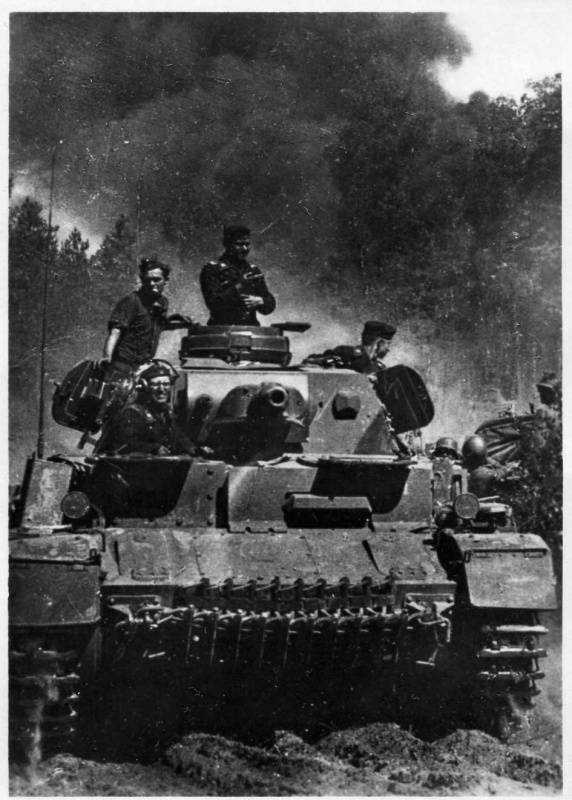
Of course, we will not be able to completely keep silent about all the Pizervaffe blitz operations, as in this case the story will turn out to be completely incomplete, but we will limit ourselves to a brief mention of them.
We begin with Army Group North, Field Marshal von Leeb, who was the weakest of all. It consisted of two armies and one tank group. Von Leeb's actions are interesting in that he practically did not interact with the neighboring Army Group Center, and the 4-I Goepner Tank Group in general turned out to be a kind of “thing in itself”. Von Leeb later honestly admitted that he understood almost nothing about the actions of large tank formations, which resulted in more than strange orders. He constantly pulled up Göpner, not realizing that a blitzkrieg is inevitably associated with a bit of risk. As a result, the Reinhardt XLI Corps and the Manstein LVI Corps acted on its own. The result was obvious - the North-Western Front avoided major disasters such as the Minsk and Kiev boilers. But this makes it easier for General F.I. Kuznetsov is gone. If von Leeb acted unsuccessfully, then Kuznetsov and Voroshilov, who replaced him, were generally disgusting.
Army Group "North" simply and artlessly advanced on Leningrad along the shortest path. If we recall Rommel's African campaigns, the question immediately arises: couldn’t it have been possible to try to cut off and surround the North-Western Front with a tank attack on Riga? It was probably possible, but Rommel was needed for this, not von Leeb. His tank corps also moved in a straight line, although their influence on the overall course of the campaign should not be underestimated. First of all, they saved the German infantry from serious problems when the Reinhardt Corps repelled the blow of the Soviet 23 and 3 mechanized corps, which had about 12 tanks, on 1400 in June. They were met by the Reinhardt XLI Corps, which had five times fewer tanks, with more than half of them being terrible 35 (t). But something happened that then repeated more than once, not two and not twenty-two. Soviet tank regiments and battalions delivered uncoordinated strikes and died one after another under the fire of German artillery. After the 3 days of fighting, the Soviet mechanized corps ceased to exist, and Reinhardt calmly headed for Dvina.
There also rushed and the body of Manstein. He did not have to fight, so 26 June managed to easily capture the most important bridge in Daugavpils. The mobility of tank units in this operation was used to the maximum, for four days the LVI corps traveled about 350 kilometers, and notice, unlike in the Soviet corps, it was not single tanks that arrived at the target, but almost all the divisions. After this, Manstein had to fight alone for 3 days, holding a strategically important point.
Bush’s 16 Army I tried my best to keep up with Manstein, but she didn’t succeed. In addition, she should have maintained contact with the Army Group Center, which was not possible at all. The gap in the German front in the Great Onions region gradually became rampant, but the Red Army was not in a position to use it. Although the Reinhardt Corps was behind Manstein, he also managed to seize the bridges across the Dvina in the Jekabpils region. However, at this moment, von Leeb for several days delayed his tanks at the turn of the Dvina. He intends to tighten the lagging infantry divisions and align the front line.
After a respite, the Göpner tank corps moved further to the Island and Opochka. Once again, the 1 Panzer Division calmly captures an important bridge across the Velikaya River in Ostrov. Recognizing themselves, the Soviet generals are trying to repel him, but this only leads to great losses, although for some time the outcome of the battle hangs by a thread. 6 July Manstein Corps, unexpectedly, flew into the swamps around Opochka. It turned out that the Germans had a bad idea of the terrain along which they were to move. The question arises: what to do next? To go to the aid of Reinhardt or to attack on their own through the Old Russ? After heated debates, it was decided to stop at the second version. At a meeting of 9 in July with the participation of von Brauchitsch, von Leeb and Goepner, it was decided that the 4-I tank group launched an offensive on Leningrad in two directions. The Reinhard Corps will go through Pskov and the lower Luga, and the Manstein Corps will go through Novgorod. Impassable swamps separate these two routes, and it is possible to split these corps one by one, especially since they have already suffered significant losses, but the Soviet armies are limited to passive defense.
Göpner, Manstein and Reinhardt were in favor of uniting the tank corps, but von Leeb decided in his own way.
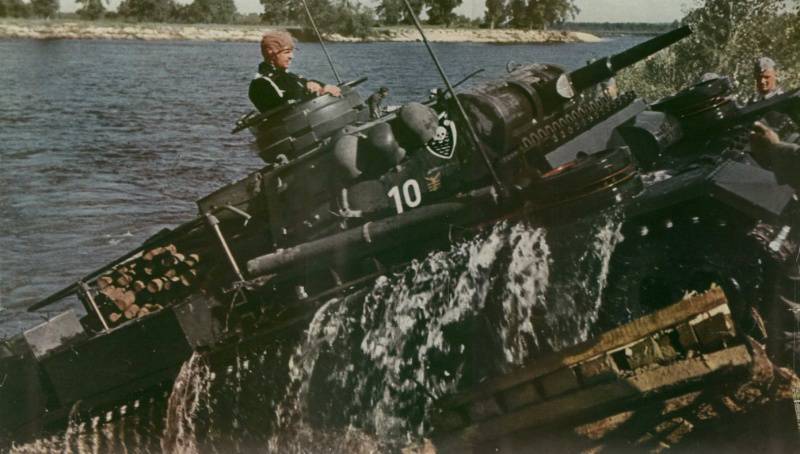
The XLI Corps continues its attack on Pskov and further, once again the most important bridges are captured without a fight, and the Reinhardt tanks are already in 100 kilometers from Leningrad. The Soviet command hastily transferred part of the forces of the Northern front, General Popov, to the Luga frontier; in Leningrad, civilians are mobilizing for the construction of fortifications. But Reinhardt was already exhausted, moreover, he was too far from his rear. Until 19 August, its hull is forced to rely solely on air-delivered supplies. Von Leeb failed to ensure the work of the rear, corresponding to the pace of modern operations, he failed to coordinate the actions of his forces, and, as Reinhardt wrote with undisguised irritation, the most favorable opportunity to seize Leningrad was missed.
The corps of Manstein at this time was wading through the forests and swamps from Opochka to Novgorod all alone. Taking advantage of his vulnerable position, 11-I army of General Vatutin delivered Manstein a counter blow near Soltsy. And this German corps was in an extremely dangerous position, but it remained, although it suffered great losses in the 14 – 18 battles in July. As a result, Army Group "North" completed all the tasks set for the first period of the offensive, although it was completely exhausted and needed rest and replenishment. Tank corps proved that they can deliver deep dissecting blows, but these blows did not bring dividends, because von Leeb separated them, and in addition showed that he didn’t know how to consolidate their successes with infantry. This played a role, as the corps suffered losses in forced defensive battles, to which they were not too adapted, because the tank was always an offensive weapon.
Only 8 August von Leeb's troops managed to go on the offensive, but now the battles were of a different nature. Although the Reinhardt Corps was strengthened, it took him 4 of the day to break through the defenses at the Luga line. By September 8, the Germans reached Mga station and captured Shlisselburg, cutting off Leningrad from the land, but at that their attack was once again slowed down. The attempt to storm Leningrad, undertaken in September, was already a hopeless undertaking, since the number of most German divisions had shrunk by a factor of three. After the war, justifying himself, von Leeb said that he did not expect to reach the gates of Leningrad at all, let alone take the city. In general, oddly enough, von Leeb’s tanks really played a fairly prominent role in the actions of Army Group North, ensuring the free advance of the infantry, but did not bring it victory. Without tanks, von Leeb probably would not have gone half the distance from the border to Leningrad. And this somewhat strange tank war proved once again the dubious postulates of the theory of deep operations. Göpner’s breakthroughs were obtained, but that was the end, since they didn’t bring any real benefits.
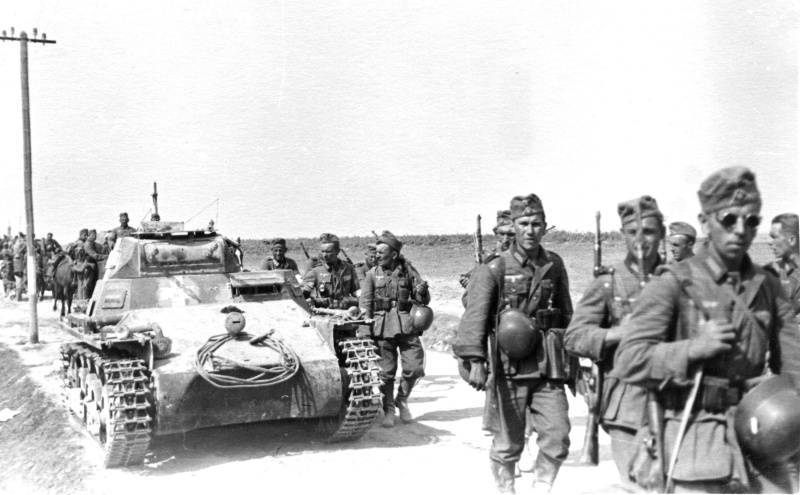
As you might guess, in the first period of the war, the main events took place in the zone of the German Army Group "Center", which consisted of two tank groups. The 3-I tank group on June 24 moved to the Vilnius area, and the 2-I tank group that advanced to the south - to the Slonim area. The defense of the Western Front was dissected in several places, the counterattacks that General Pavlov tried to inflict in pursuance of Directive No. 3 failed. The most vivid example of the helplessness of the Soviet command was the so-called counter attack by the Boldin group near Grodno, during which the powerful 6 mechanic corps simply melted, surpassing any of the German tank groups in the number of tanks. Tanks of Guderian and Goth rushed forward to Minsk, and in the meantime one of the first boilers was gradually created in the area of the Belostok projection. We could put it in the merit of Pancerwaffe, but the strangeness of the situation is that the boiler was shaped by the efforts of the German infantry. VII and IX corps advanced from the south-west, XX and VIII from the north.
The June 24 battles, in which German mechanized corps participated, led to the defeat of the second echelon of the Western Front and managed to slow down the German offensive very briefly. On June 10, Goth and Guderian’s tanks met in Minsk, and the next day the infantry of the 28 and 4 armies closed the encirclement around the Soviet troops who were trying to escape from the Belostok salient. In this double ring were 9 Soviet divisions. The fighting in the Bialystok boiler ended on July 23, and the Minsk boiler was liquidated by July July 1. Unfortunately, our command has failed to take advantage of the pernicious tendency that is increasingly manifest in the actions of the German generals. If you pay attention, the boilers acquired more and more grandiose dimensions, and accordingly the front of the environment could not be dense. Actually, there is a suspicion that he did not exist as such, especially on the southern face, where Guderian’s Panzer Group acted. Two of its mechanized corps rushed off to Minsk, the XII Army Corps was busy with the Brest Fortress, and the troops of the 9 Army solved their own tasks in the area of Bialystok-Volkovysk. However, our generals failed to take advantage of this chance.
On July XN, the Soviet command attempted to launch another major counterstrike at Lepel, in which two mechanized corps participated: the 6 and 5. In total, they had about 7 tanks. This whole armada collided with only two German tank divisions - the 1700 and 7. The battle took exactly one day, after which it turned out that the 17 th mechanized corps of General Vinogradov lost more than half of the tanks and retreats. 7-th mechanized corps had even worse. Not only did the 5-I tank division repel all his attacks, but she also managed to stab him in the rear and drive him to the boiler.
The remains of the corps hurriedly rolled back to the Orsha, and the Germans got a completely empty Vitebsk, which there was no one to defend. The commander of the 3 tank group, General Got, describing this battle, is limited to three lines:
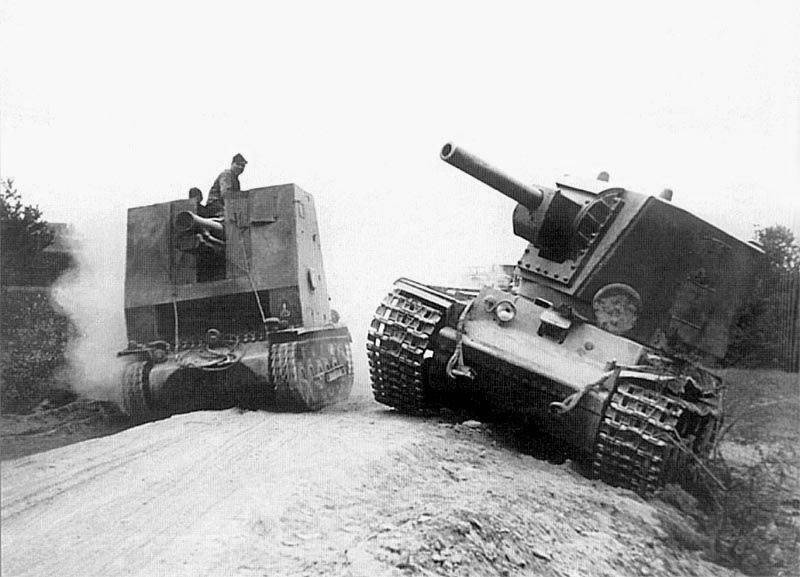
As a result, the Soviet troops retreated to Smolensk, where another boiler had already begun to form. In general, von Bock used the tanks assigned to him for all 100 percent. If you look at the map, we will see that Army Group “Center” was moving from one boiler to the next, so the background story of von Bock’s will actually be the history of the classic blitzkrieg. Well, or almost classical, because the entourage of Guderian and Got succeeded well, but sometimes with the destruction of the encircled Soviet troops there were problems. The reason was simple, we already mentioned it. The craving for giantomania led to the fact that the environment ring turned out weak, and in some places just symbolic. And if the Soviet generals did not lose their heads and did not panic at a critical moment, the Germans might regret their rash actions. Moreover, the lion’s share of these mistakes was made by the illustrious Guderian.
So, in July, by joint efforts of the 2 and 3 of the tank groups near Smolensk, units of the Soviet 16 and 20 armies were surrounded. However, the Germans immediately discovered that another wall had grown in front of them, which just yesterday was not there, and the new Soviet armies not only blocked the way for German tanks, but also tried to launch several counterstrikes in order to unlock the surrounded group.
Unfortunately, these counterstrikes were again unsuccessful. Why did this happen? Once again, it turned out that many tanks were not tank forces at all. One can afford such a historical analogy: the difference between the Pancervaffe-41 and the Soviet tank units of the same year is about the same as between the cavalry and cavalry. Both people seem to be on horseback, but ... On the one hand, we have a disorderly crowd of horsemen making noises and swinging swords, on the other - regular cavalry divisions, properly organized and managed. Of course, they can win, but with a very successful set of circumstances and with a huge numerical advantage. Just a large numerical advantage here will be completely inadequate. Let's quote from ... Do you think Mellentina? Wait, there will be you and Mellenthin, but for now we will give an excerpt from the diaries of the famous General and the man of desperate courage - Denis Davydov.
Commanding some of the Cossacks, we buzzed around successive enemy columns, from which fallen carts and guns fought back, sometimes they picked up platoons scattered or stretched along the way, but the columns remained unharmed.
I now see Count Orlov-Denisov prancing around the column on his red horse, surrounded by my Akhtyr hussars and orderlies of the Life Guard Cossack regiment. Colonels, officers, constables, many simple Cossacks rushed to the very front, but all was in vain! The columns were poured one by one, driving us away with rifle shots, and laughed at our unsuccessful chivalry around them. ”
Davydov writes bitterly that "our Asian attacks were powerless against the European order." That's what this is about. The Cuirassier Division, with a hussar division attached to it, having a battery of mounted assault troops put in place, will disperse any cavalry. The same thing happened with tanks.
First, the Russian tank armies had to pay dearly for the lack of combat experience. Especially poor understanding of the methods of conducting tank battles and lack of ability to show junior and middle commanders. They lacked courage, tactical foresight, the ability to make quick decisions. The first operations of tank armies ended in complete failure. Dense masses of tanks were concentrated in front of the German defense, in their movement felt insecurity and the absence of any plan. They interfered with each other, ran into our anti-tank guns, and in the event of a breakthrough, our positions stopped advancing and stopped, instead of developing success. These days, individual German anti-tank guns and 88-mm guns acted most efficiently: sometimes one gun damaged and incapacitated more than 30 tanks in one hour. It seemed to us that the Russians had created a tool that they would never learn to own, but already in the winter of 1942 / 43, the first signs of improvement appeared in their tactics. ”
M. Baryatinsky, describing the combat use of Soviet tanks at the beginning of the war, gives excerpts from the memories of our tank commanders of the lower echelon. Here and there the phrase flashes: "I signaled" Do as I do. " That is, the battalion commander stuck a signal flag in the flap on the roof of the tower and waved it. All this happens in the midst of battle, please note. And the battalion, seeing the box, obediently executed the command. Do you believe in this? I'm not a second.
In late July, the Germans faced the question: what to do next? Formally, the Barbarossa directive was executed, but as a result, the Wehrmacht was at the same distance from the victory as June 22. The Soviet troops suffered colossal losses; indeed, the pre-war Red Army was defeated and destroyed west of the Dvina-Dnepr line, but the Germans didn’t underestimate the mobilization resource of the Soviet Union. They simply had no idea about him, and just the same huge army reappeared before them.
And at that moment Hitler was rushing over. It was necessary to move on to the second phase of the operation, but no one had even thought about it before. Panzer generals imagined that they would simply drive farther to the planned Arkhangelsk-Astrakhan frontier, just like it did during Operation Mouth, and they were forced to fight again and again. Disputes flared up. The generals wanted to attack Moscow, Hitler wanted to straighten the position on the flanks, because in the north there was a gaping hole between the forces of von Leeb and von Boc, in the south, von Rundstedt achieved some success at first, but now he just trampled on the spot. For some time, the German troops on the Eastern Front lost control, and each of the commanders acted on their own.
Finally, Hitler decided to halt the attack on Moscow and turned his attention to the flanks. Successes in Ukraine and near Leningrad could lead to the entry of Turkey into the war and push the Finns to act more decisively. The most important decisions are taken on the redeployment of tank formations to other areas, that is, the decisive role of Panzervaffe in this campaign is once again emphasized; nobody even remembers the infantry armies. In this case, the very first decision causes, to put it mildly, astonishment. XXXIX takes Schmidt’s corps from Goth and sends Göpner to help. He further acts in conjunction with the Reinhardt XLI Corps. But excuse me, wasn’t it easier to do what Göpner himself and his corps commanders repeatedly offered to merge the XLI and LVI corps? The second decision had the most serious consequences. 2-I Guderian tank group turns south. The result was the famous Kiev boiler.
I believe that now is the time to turn to actions on the southern flank of the Eastern Front. Formally, Army Group South was second in strength, although the question arises: were the Romanian armies a help or a burden? In addition, the German command made one serious political mistake. It attracted Hungary to the preparation of "Barbarossa", so a whole section of the border fell out of the plans of the Wehrmacht, and when 27 June Hungary did declare war on the Soviet Union, its army had to act, as they say, from scratch.
The first major clash in the south was the so-called tank battle in the region of Rovno, Dubno, Brody. In the previous book, we already mentioned that for the most part the Soviet mechanized corps fought with German infantry, roads, and mechanism malfunctions. The struggle turned out to be unequal, the 8, 9, 15, 19, and 22 mechanized corps practically ceased to exist. By the lack of talent and senselessness of the destruction of their own tank units, the Soviet generals of the 1941 model of the year have only one rival - the Egyptian generals of the 1967 of the year. It was even worse there: they didn’t just ruin their regiments and divisions, but handed over the equipment to the enemy in good condition, at the same time increasing Israel’s tank fleet by about 20 percent. So relative to the Soviet generals are not so bad, it is worse.
However, this pogrom was only the beginning. Von Kleist proved to be not the best commander of tank groups, he was probably even the worst of them. But his talents and skills of the average German infantry general were quite enough to outplay General Kirponos. But first, von Kleist had to repel a completely unexpected attack from the rear. Hitler set out to divide his group into separate corps and drive in three different directions. In this case, the winner was the general, not the Führer. It's a pity! You look, then the Umansky copper would not turn out, because after the termination of fights in the front line XIV and XLVIII corps struck in the direction of Zhytomyr and Berdichev. And here General Kirponos made the first major mistake. For some reason he decided that von Kleist would turn north and launch an offensive in the direction of Moscow. Instead, the XLVIII Corps of General Kempf abruptly turned south on Uman. Probably, the Germans themselves didn’t expect that a pot would come into being, which would get parts of the 6 and 12 armies, because the second half of the ticks was formed by the slowly advancing XVII army of General Stülpnagel. But as it turned out, our infantry divisions moved much slower than the German ones. By the way, as a curious historical anecdote, we can mention the allegations that Stülpnagel had mechanized units in his army. But you will never guess which ones. It was a Hungarian mechanized corps.
And after that, the famous cast of Guderian’s group to the south began, which, together with the advance of von Kleist's group directly to the east, led to the formation of the largest Kiev boiler in the history of the war. However, it was a typical blitz operation, and we described it in a previous book. In fact, they rejoice in trophies in the war, but in this case the number of captured tanks and guns horrified the German generals. For the first time, they began to understand what kind of colossus they encountered. It was at this time that Hitler utters his famous phrase:
Note also that the maneuvers of German tank formations sometimes made a strange impression. First, Guderian goes directly south, and after the operation is completed, he turns back north. The von Kleist corps, which had already reached Nikopol and Dnepropetrovsk to meet with Guderian near Lokhvitsa, head northwest, but then return to Dnepropetrovsk on their own tracks and begin to advance further to the Azov Sea coast at Berdyansk. Of course, this had its logical rationale, but the logic looks strange. Germany already lacked oil, and Hitler began to reflect on the seizure of the oil fields of the Caucasus. That is why the thinned and battered 1 tank group was tasked with capturing Rostov, but at the same time several divisions were selected from von Rundstedt to participate in the planned "Typhoon" operation. Von Kleist lost the XLVIII tank corps, in return for which he was given an XLIX mountain rifle, again a long-range sight to the Caucasus Mountains. But now the unhappy Tank Group was moving at the same speed as the neighboring VI and XVII armies. The tank war in the southern sector of the Eastern Front temporarily ceased. The center of gravity of Pancerwaffe moves into the band of the Army Group von Bock, who is preparing for a decisive throw on Moscow. The Typhoon is coming.
By the way, considering all the above, we can offer an interesting variant of the military implementation of the Barbarossa plan, namely, transferring the 4 tank group to Army Group South. The rationale is pretty simple. No one set ambitious tasks for von Leeb, and his front sector was the most unimportant, he would have moved himself slowly along the coast of the Baltic Sea. But if Rundstedt had two tank groups from the very beginning, he could act in the blitzkrieg style, as von Bock did, without waiting for the Guderian group to move south. Then the Kiev boiler could turn out much earlier, but it would not have reached him at all. Perhaps in this case the majority of the Soviet armies would have died near Uman.
Guderian was also directly benefited; he wouldn’t have needed a throw to the south, which would have taken away time and lifespan. You look, and the attack on Moscow could start earlier, however, in this case only 2 tank groups would participate in it. Although, as correctly noted, the history of the subjunctive has not.
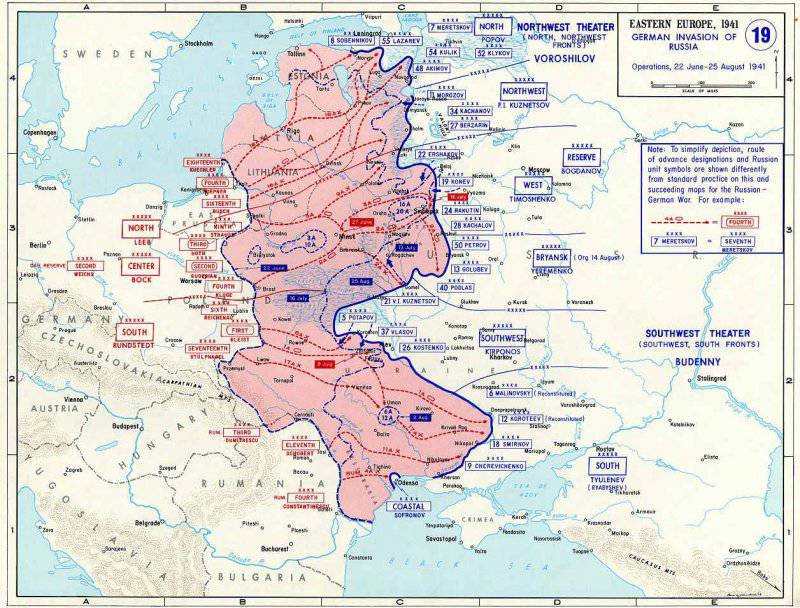
Information